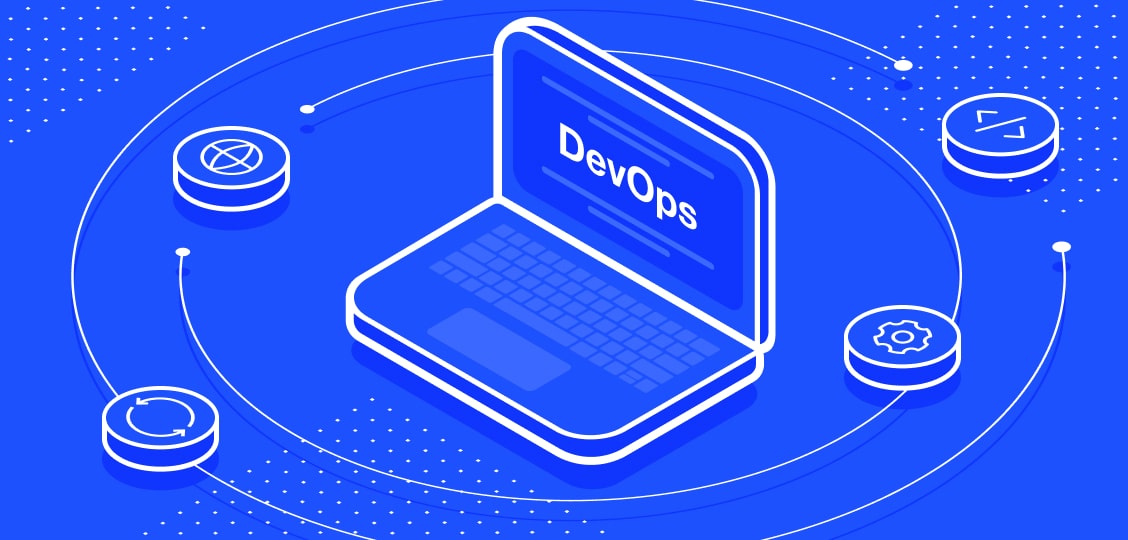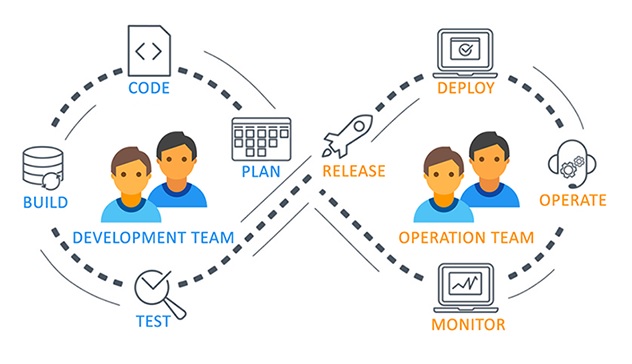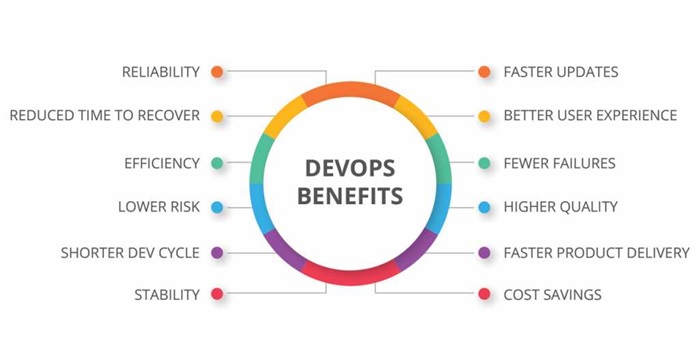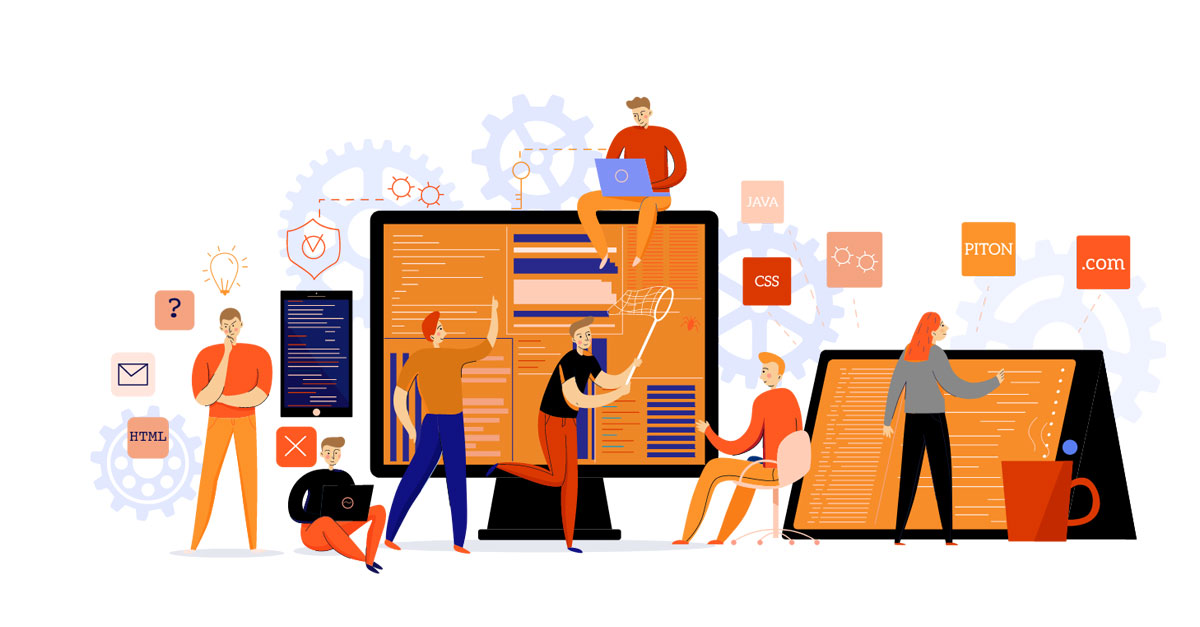
DevOps introduces an agile mindset, streamlined processes, effective tooling, and a collaborative team culture that empowers enterprises to accelerate their software delivery. Discover how implementing DevOps can play a pivotal role in driving your company’s digital transformation.
In the context of digital transformation, DevOps plays a crucial role by ensuring that all changes to develop and deploy systems, as well as IT infrastructure, are made through code in version control. This approach eliminates the uncertainties of manual configurations and enables traceability back to version control.
In essence, DevOps is the methodology that facilitates rapid, frequent, and seamless service delivery, enabled by cloud-native technologies. Its primary objective is establishing a streamlined workflow with minimal handoffs and swift feedback loops.
By accelerating software delivery, DevOps directly impacts and positively influences customer satisfaction. This, in turn, facilitates digital transformation by allowing safer and faster changes to the underlying IT infrastructure, leading to enhanced agility in software applications and services. Let’s explore how DevOps can drive the digital transformation of your company.
Changes the Cultural Mindset
DevOps is the driving force that propels transformation in contemporary businesses, regardless of whether that transformation is digital or cloud-native adoption. At its core, DevOps is all about taking a business concept and actively supporting its realization. It goes beyond mere buzzwords or technology; instead, it focuses on empowering businesses to bring their ideas to fruition and drive meaningful change.
DevOps makes Automation a Priority
DevOps has emerged as a central element for enterprises to shape their digital transformation strategies. Its fundamental principles, which involve increasing workflow, shortening feedback loops, and fostering continuous learning and experimentation, lay the foundation for making digital transformation a reality. Amidst the overwhelming focus on automating various aspects of the world, DevOps reminds us of the value of automating tasks. However, it’s important to recognize that automation alone is not the ultimate solution for DevOps or digital transformation. Instead, it must be thoughtfully crafted by people and supported by appropriate processes and a conducive culture. Nevertheless, without the automation of CI/CD/SRE processes, achieving successful digital transformation becomes significantly more challenging, limiting the potential for gaining a competitive edge in the market.
DevOps Builds Trust
According to Helen Beal, Chief Ambassador of DevOps Institute, DevOps places a significant emphasis on culture, which was not previously approached from a technology perspective. This approach prioritizes optimizing the flow of value, leading to the distribution of authority to encourage empowerment and autonomy among team members. Trust is a crucial cultural characteristic in DevOps, and it is fostered through practices such as visibility, transparency, and promoting data-driven conversations.
Aligns Business Goals with Security
In any progress, cybersecurity risks can threaten advancements if security measures are not in place. While accelerating the software development lifecycle through automation may lead to the temptation of reducing security checks for time’s sake, it remains essential to ensure that all software is secure before deployment to the public. These principles address these concerns by implementing preventive scanning, providing developer training in writing secure code, and encouraging automation in security checks throughout the process. This approach allows more time to refine the product based on feedback, rather than spending resources on postmortems after a security incident or exposure has occurred.
Encourages Experimentation
They understand that DevOps encompasses an agile mindset, tools, processes, and team culture that enables enterprises to enhance the speed of software delivery. Key principles of DevOps and digital transformation include experimentation, embracing failure early, obtaining rapid market feedback, and striving to get things right from the start.
Managers Evolve into Coaches
In the dynamic digital age, the roles of management and leadership are undergoing a shift. DevOps, by its very nature, facilitates the transformation of leaders from mere managers to effective coaches. Additionally, it empowers them to instill dynamic learning capabilities and foster psychological safety within the organization.
DevOps Makes Customers Happy
According to Mirco Hering, global DevOps practice lead at Accenture, in the past, large-scale manual efforts and fragmented delivery teams focused on cost optimization were effective when systems evolved slowly and were mainly composed of large applications. However, in the current digital world, being responsive and fast is more critical than maintaining strict control. DevOps enables organizations, both from an organizational and technological standpoint, to meet the growing challenges of complexity and speed by providing the necessary capabilities.
Agility
DevOps fosters natural collaboration, leading to increased agility for enterprises. It ensures the seamless integration, delivery, and deployment of software, allowing for continuous adaptation if necessary. The first step in achieving agility is establishing integrated delivery pipelines. In traditional non-DevOps environments, frequent requirement changes can lead to chaos due to disjointed production pipelines. However, with DevOps, integrated production pipelines enable teams to handle requirement changes, rollbacks, and infrastructure automation efficiently. Planning boards have access to product and business owners to determine feature priority and dependencies. Additionally, cloud technologies play a vital role in altering infrastructure capabilities and monitoring applications for rollbacks.
Mean Time To Recover (MTTR)
Even with the best approach, enterprises may still experience downtime and struggle to fully embrace the essence of DevOps. In a DevOps context, Mean Time To Recover (MTTR) refers to the time it takes from when a system breaks down to when teams begin efforts to restore it. DevOps aims to reduce MTTR by implementing multi-cloud strategies tailored to the application ecosystem. Downtime can occur due to network and server outages, and to mitigate this, organizations should focus on automation and adopt hybrid and multi-cloud strategies. Implementing Infrastructure as Code (IaC) with careful consideration of codebase type, architectural modifications, and cloud infrastructure can effectively reduce MTTR.
To make more progress on digital transformation goals, these practices can significantly benefit your organization. If you’re interested in DevOps but feeling overwhelmed, there’s no need to worry! Our team of highly experienced consultants is available to answer your questions and assist you on your DevOps journey.
Here at CourseMonster, we know how hard it may be to find the right time and funds for training. We provide effective training programs that enable you to select the training option that best meets the demands of your company.
For more information, please get in touch with one of our course advisers today or contact us at training@coursemonster.com












